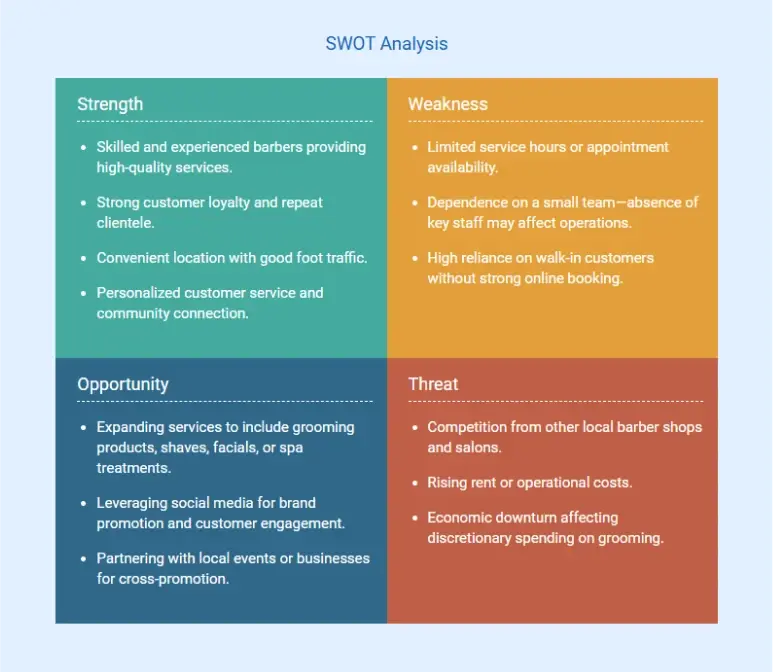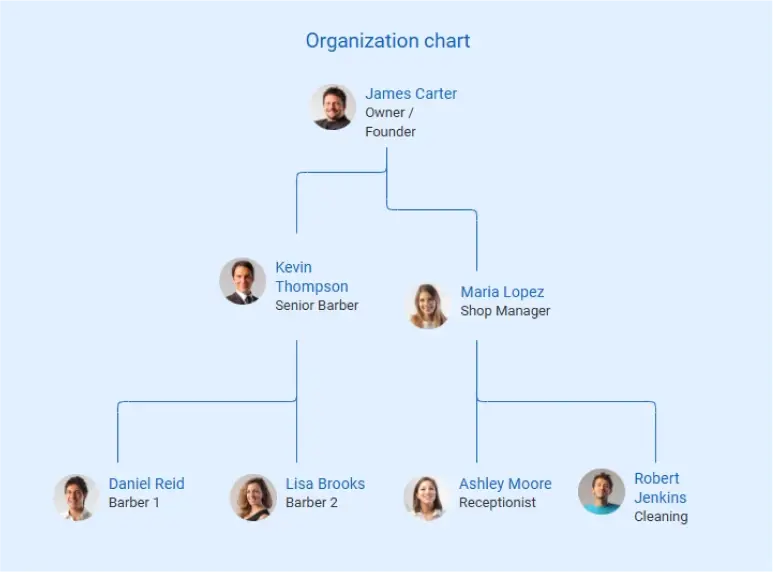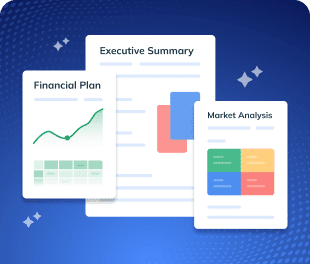Looking to start your own barber shop? That’s great!
You’ll be working with people every day, building a local spot where clients trust you for clean cuts, great service, and a bit of conversation (the kind that keeps them coming back).
But behind the scenes, there’s more to it than just cutting hair. From managing walk-ins and appointments to keeping the books and restocking supplies, there’s a lot to handle.
That’s why you need a solid business plan. One that keeps things clear, organized, and helps you grow.
Not sure where to start?
This barber shop business plan template will walk you through it (step by step).
What is a barbershop business plan?
A barber shop business plan refers to a document in whereby you indicate how you are going to start, operate, and develop your barber shop. It is actually your plan, the way you think of the first idea in everyday business life, and perspectives.
Your plan will contain all aspects of your services, the target market, your approach towards marketing, and your finances.
Why do you need a business plan for a barbershop?
Many people open a barber shop, thinking that skills and a few loyal clients are enough to sustain the business. But cutting hair is just one part of the job.
But it’s also about managing people, time, money, and keeping your chairs full every day. So, having a business plan helps you bring all of that together in one clear direction.
Here’s what a solid plan helps you figure out:
- What kind of services will you offer (basic cuts, beard trims, styling, etc)
- Who your target customers are and how to reach them
- How to price your services to stay competitive and profitable
- What it’ll cost to set up and run the shop day-to-day
- How to manage bookings, staff, and inventory
- What growth looks like, whether it’s more chairs, a second location, or extra services
In the end, great cuts bring people in, but a solid plan is what keeps your shop growing.
How to draft a solid barbershop business plan?
Let’s go through each section of your barbershop business plan should include. We’ll explain what to cover in each section so you can draft yours with confidence.
1. Executive Summary
The executive summary is a snapshot of your entire plan at a glance. It’s short, sharp, and gives the reader a quick feel for what your barbershop is all about.
Even though it comes first, it’s usually easier to write this part last, once you’ve sorted out all the details. That way, you’re just pulling out the highlights.
Here’s what to include:
| Section | Details to Include |
|---|---|
| Barbershop name & location | Mention your shop’s name and location. Highlight if it’s in a high-traffic area or has any unique advantages. |
| Services offered | List key services like haircuts, beard trims, shaves, kids’ cuts, styling, or grooming packages. |
| Target market | Define your target clients like professionals, students, families, or style-conscious crowds. |
| Unique selling point | Your unique edge—late hours, signature fade styles, straight-razor services, grooming products, atmosphere, or personalized service. |
| Revenue goals & financials | Share how you plan to earn: walk-ins, appointments, memberships, product sales. Add a rough 3–5 year revenue estimate. |
| Funding needs (if any) | If raising funds, state how much and what for: chairs, tools, rent, setup, software, or promotions. |
Keep it short, 1-2 pages max. The goal is to get someone to keep reading, not explain every little detail here.
Say goodbye to boring templates
Build your business plan faster and easier with AI
Plans starting from $14/month

2. Business Overview
This section gives a clear snapshot of your barbershop at a high level. It answers: Who are you? What are you building? Why does it matter?
Write it like you’re introducing your shop to someone who’s never heard of it. Keep it honest, detailed, and easy to follow.
Here’s what to include:
- Name and legal setup of the barbershop
- Tell us about the location of the shop and what makes it special
- Indicate who runs the business and what is relevant experience
- Tell the story of what the barbershop is all about and what it represents
Altogether, it should give a clear picture of the barbershop’s foundation.
3. Industry and Market Research
Here, you’ll define who your customers are, what they’re looking for, and how your barbershop fits into the larger market landscape.
Here’s how to break it down:
Industry overview
Start with a quick snapshot of the barbering industry. You can mention things like:
- Demand for grooming services is steady (everyone needs a haircut eventually).
- Men’s grooming is growing, especially in urban and style-conscious markets.
- Walk-in shops are still popular, but more people now expect online booking, card payments, and premium service.
If you’re in a specific niche (e.g., high-end, family-focused, or student-friendly), mention how that part of the market is doing.
Target market
Describe who your main customers are. Be specific by understanding your customers and breaking them into groups, like:
| Segment | Demographics | What they want |
|---|---|---|
| Young professionals | 25–40, mid-high income, working full-time | Quick service, stylish cuts, online booking |
| College students | 18–25, budget-conscious | Affordable pricing, walk-ins, clean fades |
| Dads & kids | 30–50, families | Friendly atmosphere, reliability, kids’ cuts |
| Style-focused clients | 20–35, trend-driven | Sharp fades, beard work, product recommendations |
Location analysis
Explain why your chosen location makes sense. Questions to answer:
- Is there good foot traffic?
- Are there offices, schools, gyms, or apartments nearby?
- Are there already too many barbers in the area, or is there a gap?
Around 9% of small businesses fail because of a bad location, so choose wisely and back it up with real data.
Market needs and trends
Wrap it up with what your market is looking for, and how you’ll meet that need.
Examples:
- “More men want barbers who can do modern fades and beard shaping.”
- “People want online booking and short wait times.”
- “Customers are tired of rushed, impersonal cuts—they want someone they can trust.”
This part shows that your shop isn’t just another business; it’s answering a clear demand.
4. Competitive Analysis
Every neighborhood has a few barbershops. This section is about understanding what your competitors do well, where they fall short, and how your barbershop can fill a gap.
Local competitor overview
Start by listing a few shops near your planned location. These might include:
- Walk-in-only shops with basic cuts
- High-end grooming studios
- Chains or franchises
- Old-school legacy shops that have been around for years
For each one, take note of:
- Services offered
- Price range
- Reviews (Google, Yelp, etc.)
- Strengths and weak points (e.g., long wait times, no online booking, inconsistent service)
Then, lay out a comparison table of strengths and weaknesses to identify what you can offer that will attract customers to your shop.
What makes you different
Now, explain where you fit in and why customers would pick you.
Are you offering faster service, better fades, a better location, a more modern vibe, or more attention to detail?
Whatever it is, be specific. Example: “While most local shops focus on walk-ins, we’ll offer a fully online booking system with guaranteed appointment slots, ideal for professionals who don’t want to wait.”
This shows you’ve found the gap and you’re sticking to it.
SWOT analysis
If you want to make this even clearer, you can include a quick SWOT table like this:

5. Products and Services
This section breaks down exactly what your barbershop will offer. Start with the core services, then go into the extras that help boost revenue or set you apart.
Core services
These are the main reasons people walk into your shop, so include:
- Haircuts (classic, fades, trims, etc.)
- Beard trims and shaping
- Shaves (straight razor, hot towel)
- Kids’ cuts
- Line-ups or edge-ups
- Styling (optional add-on after a cut)
You can group them into service tiers, like:
| Service Type | Description | Price Range (sample) |
|---|---|---|
| Standard cut | Basic haircut, wash, and style | $25–$35 |
| Premium cut | Cut + detailed styling + hot towel | $40–$50 |
| Beard trim only | Trim + shape + oil finish | $15–$25 |
| Hair & beard set | Combo service | $45–$60 |
Add-ons and specialties
These are nice-to-haves that boost your per-client revenue or offer a better experience:
- Hot towel service
- Scalp massage
- Gray coverage (hair or beard)
- Skin fades or specialty cuts (designs, undercuts)
- Hair wash or styling with premium products
Products offering
You can also make money through product sales, either at the front desk or directly from the chair, including:
- Pomades, gels, or styling creams
- Beard oils, balms, and combs
- Aftershave, moisturizers, or toners
- Hairbrushes, razors, and grooming kits
Pricing strategy
Don’t forget to mention how you’ll set your prices.
- Will you charge above average for a premium vibe?
- Will you offer budget cuts to bring in volume?
- Will you run memberships or loyalty programs?
You can also mention early-bird deals, student discounts, or upsell options (“Add beard trim for $10”).
6. Marketing Plan
The marketing plan explains your strategies to attract and keep customers. Start by describing the marketing channels you’ll use, for example:
- Social media (Instagram or Facebook to show off fresh cuts)
- Local ads
- Flyers
- Grand opening promotion
Don’t forget customer retention tactics, how you’ll encourage clients to come back and refer others. This could be through a loyalty program or simply excellent customer service and follow-ups.
As an example, one barber shared that he gives the 11th haircut free to customers who are loyal. Such little rewards can really help to retain people.
In general, show that you have an implementation plan to spread the word and gain a loyal client base instead of crossing fingers and hoping for the walk-in traffic.
7. Organization and Management Team
Use this section to outline your team behind the shop. Introduce the owner(s) and any key team members. If it’s just you, talk about your experience and how you’ll handle both cutting hair and managing the business.
If you have a team, list how many barbers you’ll have and any other staff (like a receptionist or assistant, if applicable).
Highlight any relevant experience or qualifications. For example, if you or one of your barbers has 10+ years of experience or special training, highlight that.
It’s also good to mention how the team is structured. Who is responsible for what? You can include an organizational chart to show the hierarchy or roles. For example:

Basically, this section assures readers that you have (or will have) the right people in place to make the business run smoothly.
8. Operations Plan
The operations plan section explains the day-to-day running of your barbershop. It gives readers an insight into the practical side of operating a barbershop efficiently.
The following are a few questions to answer while drafting your operations plan:
- Who will manage the shop, and how many barbers or staff will you hire?
- What will your working hours be? Will you open on weekends too?
- Will you take walk-ins, appointments, or both?
- How many chairs/stations will you set up, and how will you manage tools and supplies?
- How will you accept payments—cash, cards, UPI, or mobile apps?
- What’s your routine for cleaning, sanitizing tools, and keeping hygiene in check?
- How will you ensure a consistent, quality experience for every customer?
By covering these key points, you show readers that you understand what it takes to run a barbershop.
9. Financial Projections
The financial projections section shows how your barbershop will earn revenue, manage costs, and stay profitable over time. Projections can be added for the next 3-5 years with core components such as:
Revenue projections
Start by estimating your monthly revenue based on service volume and pricing. For example:
- Daily clients: 20
- Average ticket: $30 (includes basic haircut + occasional upsells)
- Working days per month: 22
- Monthly revenue: 20 × $30 × 22 = $13,200
Add-ons like beard trims, color treatments, express services, and product sales can boost revenue. If that sales up to 10 to 15 %, that’s an extra $1,300 to $2,000 per month.
Operating expenses
Operating costs fall into three categories:
- Fixed expenses: Rent, insurance, software subscriptions, utilities, and licensing fees
- Variable expenses: Hair products, laundry services, towel supplies, refreshments, and part-time staff wages
- Startup costs: Chairs, mirrors, renovation work, POS systems, and initial marketing campaigns
Also consider merchant processing fees and app-based reservation or POS tools (e.g., Square, Fresha).
Profit & loss forecast
In the first year, you may want to track monthly P&L closely. Based on the above example:
- Revenue: ~$15,000/month
- Estimated expenses: ~$10,000/month
- Net profit: ~$5,000/month
As client flow increases and fixed costs remain relatively stable, your margins should improve over time.
Cash flow projections
Cash flow stays positive with steady clients and controlled costs. Daily payments help maintain short-term stability. See the table below for a breakdown of projected monthly inflows and outflows:
| Category | Year 1 | Year 2 | Year 3 |
|---|---|---|---|
| Cash inflows | |||
| Services revenue | $105,000 | $131,250 | $164,063 |
| Product sales | $7,500 | $9,375 | $11,719 |
| Capital/loan injection | $20,000 | – | – |
| Total cash inflows | $132,500 | $140,625 | $175,781 |
| Cash outflows | |||
| Rent | $24,000 | $24,720 | $25,462 |
| Staff salaries | $18,000 | $27,000 | $35,000 |
| Supplies & inventory | $9,000 | $11,250 | $13,688 |
| Marketing | $4,800 | $5,000 | $5,500 |
| Software & admin | $2,400 | $2,600 | $2,800 |
| Loan repayment | $4,000 | $4,000 | $4,000 |
| Taxes (Est. 25%) | $11,025 | $14,656 | $20,541 |
| Total cash outflows | $73,225 | $89,176 | $107,991 |
| Net cash flow | $59,275 | $51,449 | $67,790 |
| Opening cash balance | $0 | $59,275 | $110,724 |
| Ending cash balance | $59,275 | $110,724 | $178,514 |
Balance sheet
Your balance sheet may include:
- Assets: Equipment, initial cash reserve, product inventory
- Liabilities: Any startup loans, supplier credit, lease obligations
- Owner’s equity: Your personal investment and retained earnings
Break-even analysis
This analysis helps you understand the minimum performance needed to cover your costs:
“With fixed monthly expenses of $10,000 and a $30 average ticket size, the shop needs to perform roughly 334 services per month to break even (about 15 clients/day).”
Note: The figure should feel realistic based on your assumptions and capacity.
Also, include a contingency buffer or small line of credit. Since barbershops depend on foot traffic and local trends, it’s smart to plan for slow periods or unexpected costs.
10. Appendix
Use this space for anything that supports your plan but isn’t covered in the main sections, such as:
- Floor plan sketch
- Service menu
- Pricing sheet
- Resume(s) or licenses
- Product list or supplier quotes
- Sample marketing materials
- Photos of the location (if already secured)
It’s optional, but if you have extra materials that help the main plan, this is the place to include them.
Download a free barbershop business plan template
Ready to pull your plan together? We’ve got something to make it easier.
Download our free barbershop business plan template (PDF) to get a clear structure and helpful prompts for every section, from the executive summary to your financials.
Just plug in your shop’s details, adjust the numbers, and you’re good to go.
The Quickest Way to turn a Business Idea into a Business Plan
Fill-in-the-blanks and automatic financials make it easy.
Conclusion
By now, you’ve got a solid understanding of how to draft a practical business plan for your barber shop.
And with the free template and guide in hand, you’re already one step ahead.
Still want to save time or add polish to your plan?
Give Upmetrics a try. It makes the planning process faster, smarter, and a lot less stressful, with helpful tools like financial forecasting, drag-and-drop outlines, and real-time editing.
So go ahead, start planning with confidence.



